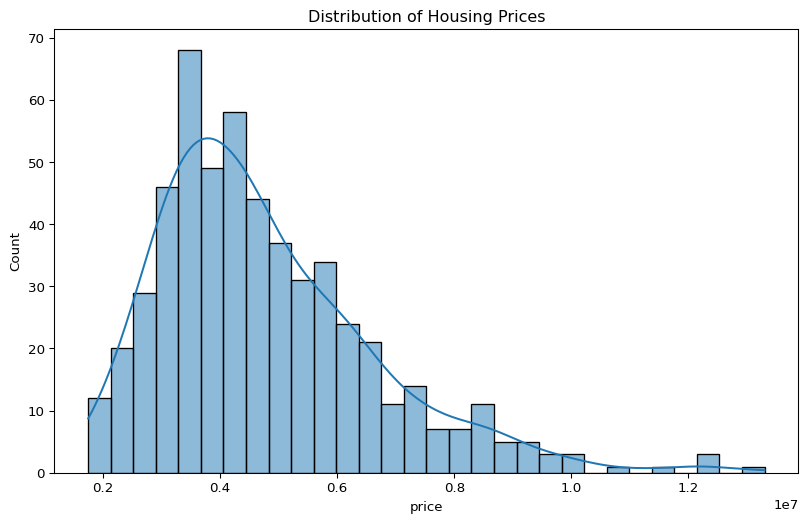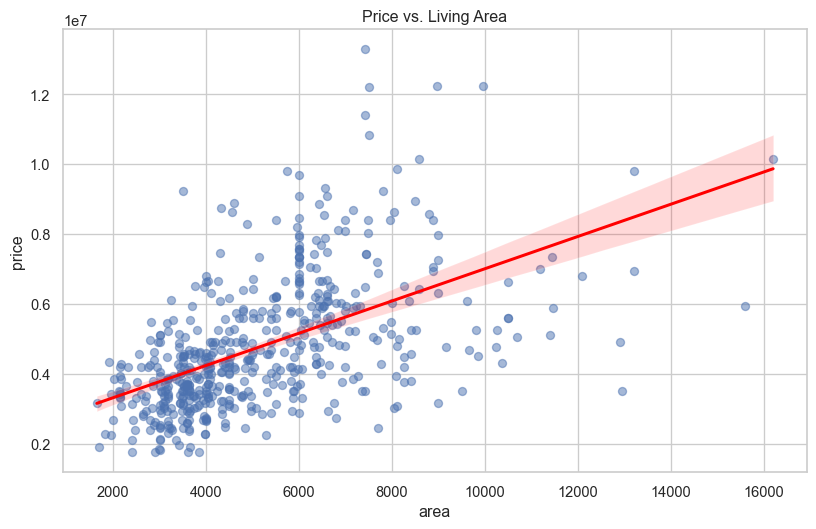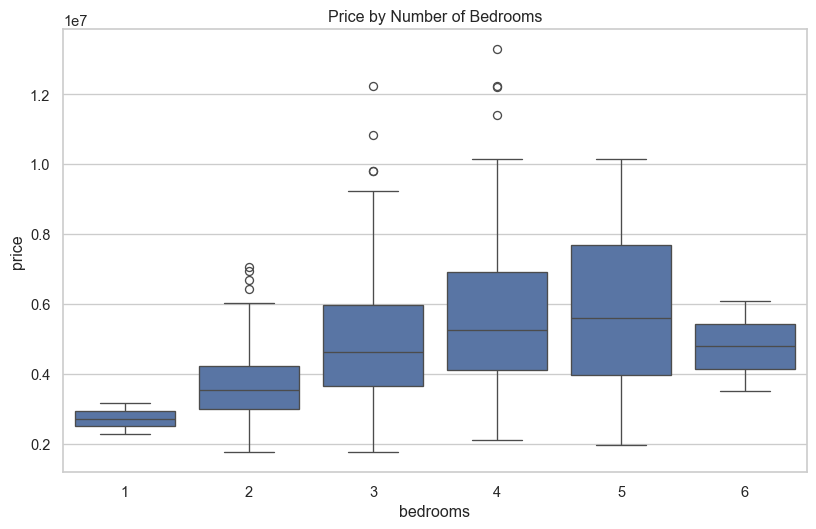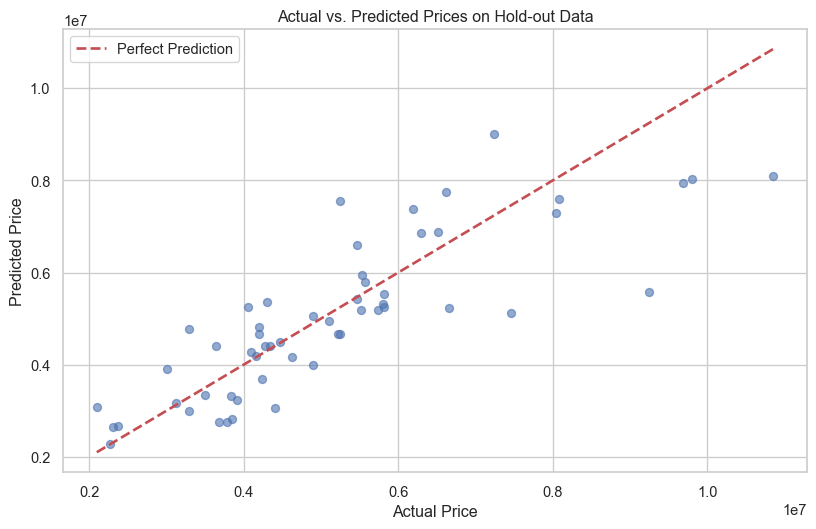Code
# This command installs all necessary libraries.
# It's set to not evaluate by default to avoid re-installing every time.
!pip install scikit-learn pandas numpy matplotlib seaborn xgboost joblibUsing Scikit-learn
This document provides a comprehensive, step-by-step guide to building a regression model using Python and the scikit-learn library. We will use a housing dataset to predict house prices, a classic regression problem. This project will walk you through the entire machine learning pipeline, from initial data loading and exploratory data analysis (EDA) to sophisticated model training, hyperparameter tuning, and final model evaluation.
The primary goal is to demonstrate a robust and reproducible workflow for regression tasks. We will explore various algorithms, compare their performance, and select the best model for making predictions on unseen data.
First, we ensure that all the required Python libraries are installed using pip.
Next, we load the libraries that will be used throughout the analysis. Each library serves a specific purpose, from data manipulation (pandas) to modeling (scikit-learn) and visualization (matplotlib, seaborn).
# Core libraries
import pandas as pd
import numpy as np
import joblib
# Plotting
import matplotlib.pyplot as plt
import seaborn as sns
# Scikit-learn for preprocessing and modeling
from sklearn.model_selection import train_test_split, KFold, GridSearchCV
from sklearn.preprocessing import StandardScaler, OneHotEncoder
from sklearn.impute import SimpleImputer
from sklearn.compose import ColumnTransformer
from sklearn.pipeline import Pipeline
from sklearn.metrics import mean_squared_error, r2_score, mean_absolute_error
# Models
from sklearn.linear_model import LinearRegression, Lasso
from sklearn.ensemble import RandomForestRegressor
from xgboost import XGBRegressorWe load the housing dataset from a CSV file into a pandas DataFrame. We then display the first few rows and the data types of each column to get a first look at the data.
<class 'pandas.core.frame.DataFrame'>
RangeIndex: 545 entries, 0 to 544
Data columns (total 13 columns):
# Column Non-Null Count Dtype
--- ------ -------------- -----
0 price 545 non-null int64
1 area 545 non-null int64
2 bedrooms 545 non-null int64
3 bathrooms 545 non-null int64
4 stories 545 non-null int64
5 mainroad 545 non-null object
6 guestroom 545 non-null object
7 basement 545 non-null object
8 hotwaterheating 545 non-null object
9 airconditioning 545 non-null object
10 parking 545 non-null int64
11 prefarea 545 non-null object
12 furnishingstatus 545 non-null object
dtypes: int64(6), object(7)
memory usage: 55.5+ KB
None| price | area | bedrooms | bathrooms | stories | mainroad | guestroom | basement | hotwaterheating | airconditioning | parking | prefarea | furnishingstatus | |
|---|---|---|---|---|---|---|---|---|---|---|---|---|---|
| 0 | 13300000 | 7420 | 4 | 2 | 3 | yes | no | no | no | yes | 2 | yes | furnished |
| 1 | 12250000 | 8960 | 4 | 4 | 4 | yes | no | no | no | yes | 3 | no | furnished |
| 2 | 12250000 | 9960 | 3 | 2 | 2 | yes | no | yes | no | no | 2 | yes | semi-furnished |
| 3 | 12215000 | 7500 | 4 | 2 | 2 | yes | no | yes | no | yes | 3 | yes | furnished |
| 4 | 11410000 | 7420 | 4 | 1 | 2 | yes | yes | yes | no | yes | 2 | no | furnished |
EDA is a crucial step to understand the data’s underlying structure, identify missing values, and uncover relationships between variables and the target, price.
price area bedrooms bathrooms stories \
count 5.450000e+02 545.000000 545.000000 545.000000 545.000000
mean 4.766729e+06 5150.541284 2.965138 1.286239 1.805505
std 1.870440e+06 2170.141023 0.738064 0.502470 0.867492
min 1.750000e+06 1650.000000 1.000000 1.000000 1.000000
25% 3.430000e+06 3600.000000 2.000000 1.000000 1.000000
50% 4.340000e+06 4600.000000 3.000000 1.000000 2.000000
75% 5.740000e+06 6360.000000 3.000000 2.000000 2.000000
max 1.330000e+07 16200.000000 6.000000 4.000000 4.000000
parking
count 545.000000
mean 0.693578
std 0.861586
min 0.000000
25% 0.000000
50% 0.000000
75% 1.000000
max 3.000000 
sns.set_theme(style="whitegrid")
# Price vs. Area
plt.figure(figsize=(10, 6))
sns.regplot(data=housing_df, x='area', y='price', scatter_kws={'alpha':0.5}, line_kws={'color':'red'})
plt.title('Price vs. Living Area')
plt.show()
# Price by number of bedrooms
plt.figure(figsize=(10, 6))
sns.boxplot(data=housing_df, x='bedrooms', y='price')
plt.title('Price by Number of Bedrooms')
plt.show()

Boxplots are an effective way to visualize the distribution of numerical features and identify potential outliers.

We convert the binary categorical variables (‘yes’/‘no’) to a numerical format (1/0). This is a common preprocessing step for many machine learning models.
housing_clean = housing_df.copy()
for col in housing_clean.columns:
if housing_clean[col].dtype == 'object':
housing_clean[col] = housing_clean[col].map({'yes': 1, 'no': 0})
# Define feature types
TARGET = 'price'
# All other columns are predictors
FEATURES = [col for col in housing_clean.columns if col != TARGET]
X = housing_clean[FEATURES]
y = housing_clean[TARGET]
print(X.info())<class 'pandas.core.frame.DataFrame'>
RangeIndex: 545 entries, 0 to 544
Data columns (total 12 columns):
# Column Non-Null Count Dtype
--- ------ -------------- -----
0 area 545 non-null int64
1 bedrooms 545 non-null int64
2 bathrooms 545 non-null int64
3 stories 545 non-null int64
4 mainroad 545 non-null int64
5 guestroom 545 non-null int64
6 basement 545 non-null int64
7 hotwaterheating 545 non-null int64
8 airconditioning 545 non-null int64
9 parking 545 non-null int64
10 prefarea 545 non-null int64
11 furnishingstatus 0 non-null float64
dtypes: float64(1), int64(11)
memory usage: 51.2 KB
NoneTo properly evaluate our models, we split the data into three sets: a training set (for model building), a testing set (for tuning and initial evaluation), and a final hold-out set (for unbiased final validation).
# First, split into training+testing (90%) and hold-out (10%)
X_train_test, X_holdout, y_train_test, y_holdout = train_test_split(
X, y, test_size=0.1, random_state=123
)
# Next, split the 90% into training (7/9) and testing (2/9)
X_train, X_test, y_train, y_test = train_test_split(
X_train_test, y_train_test, test_size=(2/9), random_state=123
)
print(f"Training data shape: {X_train.shape}")
print(f"Testing data shape: {X_test.shape}")
print(f"Hold-out data shape: {X_holdout.shape}")Training data shape: (381, 12)
Testing data shape: (109, 12)
Hold-out data shape: (55, 12)A scikit-learn pipeline is a powerful tool for chaining multiple preprocessing steps together. This ensures that the same transformations are applied consistently to all data splits.
Our pipeline will: - Impute any missing values with the mean of the column. - Scale all numeric features to have a mean of 0 and a standard deviation of 1.
We will define a suite of regression models and their hyperparameter grids for tuning.
models = {
'LinearRegression': LinearRegression(),
'Lasso': Lasso(random_state=123),
'RandomForest': RandomForestRegressor(random_state=123),
'XGBoost': XGBRegressor(random_state=123)
}
# Define parameter grids for GridSearchCV
param_grids = {
'Lasso': {
'model__alpha': [0.1, 1.0, 10, 100, 1000]
},
'RandomForest': {
'model__n_estimators': [100, 200],
'model__max_depth': [10, 20, None],
'model__min_samples_leaf': [1, 2, 4]
},
'XGBoost': {
'model__n_estimators': [100, 200],
'model__learning_rate': [0.01, 0.1, 0.2],
'model__max_depth': [3, 5, 7]
}
}We’ll loop through our models, create a full pipeline for each, and use GridSearchCV to find the best hyperparameters based on cross-validation.
fitted_models = {}
cv_results = []
# 5-fold cross-validation
cv = KFold(n_splits=5, shuffle=True, random_state=123)
for name, model in models.items():
# Create the full pipeline
pipeline = Pipeline(steps=[('preprocessor', preprocessor),
('model', model)])
print(f"--- Training {name} ---")
# Use GridSearchCV for tunable models
if name in param_grids:
grid_search = GridSearchCV(pipeline, param_grids[name], cv=cv, scoring='neg_root_mean_squared_error', n_jobs=-1, verbose=1)
grid_search.fit(X_train, y_train)
best_score = -grid_search.best_score_
print(f"Best RMSE for {name}: {best_score:.2f}")
print(f"Best params: {grid_search.best_params_}")
fitted_models[name] = grid_search.best_estimator_
cv_results.append({
'model': name,
'best_rmse': best_score,
'best_params': grid_search.best_params_
})
# Fit baseline Linear Regression
else:
pipeline.fit(X_train, y_train)
y_pred = pipeline.predict(X_test)
rmse = np.sqrt(mean_squared_error(y_test, y_pred))
print(f"Test RMSE for {name}: {rmse:.2f}")
fitted_models[name] = pipeline
cv_results.append({
'model': name,
'best_rmse': rmse,
'best_params': 'N/A'
})
# Convert results to a DataFrame
cv_results_df = pd.DataFrame(cv_results).sort_values(by='best_rmse').reset_index(drop=True)--- Training LinearRegression ---
Test RMSE for LinearRegression: 1072360.88
--- Training Lasso ---
Fitting 5 folds for each of 5 candidates, totalling 25 fitsBest RMSE for Lasso: 1112526.55
Best params: {'model__alpha': 1000}
--- Training RandomForest ---
Fitting 5 folds for each of 18 candidates, totalling 90 fitsBest RMSE for RandomForest: 1146597.39
Best params: {'model__max_depth': 10, 'model__min_samples_leaf': 1, 'model__n_estimators': 200}
--- Training XGBoost ---
Fitting 5 folds for each of 18 candidates, totalling 90 fitsBest RMSE for XGBoost: 1149680.30
Best params: {'model__learning_rate': 0.1, 'model__max_depth': 3, 'model__n_estimators': 200}Let’s examine the performance of all our trained models.
--- Cross-Validation Results (Ranked by RMSE) ---
model best_rmse \
0 LinearRegression 1.072361e+06
1 Lasso 1.112527e+06
2 RandomForest 1.146597e+06
3 XGBoost 1.149680e+06
best_params
0 N/A
1 {'model__alpha': 1000}
2 {'model__max_depth': 10, 'model__min_samples_l...
3 {'model__learning_rate': 0.1, 'model__max_dept... price), making it interpretable. Lower values are better.Based on our cross-validation results, we select the best model and save the fitted pipeline object for future use.
best_model_name = cv_results_df.iloc[0]['model']
best_model_pipeline = fitted_models[best_model_name]
print(f"Best model is: {best_model_name}")
# Save the final model pipeline object
joblib.dump(best_model_pipeline, '../data/best_housing_model_python.joblib')
print("Best model saved to data/best_housing_model_python.joblib")Best model is: LinearRegression
Best model saved to data/best_housing_model_python.joblibWe can now load the saved model object for deployment or future predictions.
Model loaded successfully.
Pipeline(steps=[('preprocessor',
Pipeline(steps=[('imputer', SimpleImputer()),
('scaler', StandardScaler())])),
('model', LinearRegression())])Finally, we evaluate our best model on the hold-out data, which it has never seen before. This provides the most realistic estimate of its performance on new, unseen data.
# Make predictions
y_pred_holdout = loaded_model.predict(X_holdout)
# Calculate final metrics
rmse_holdout = np.sqrt(mean_squared_error(y_holdout, y_pred_holdout))
r2_holdout = r2_score(y_holdout, y_pred_holdout)
mae_holdout = mean_absolute_error(y_holdout, y_pred_holdout)
print("--- Final Model Performance on Hold-out Set ---")
print(f"RMSE: {rmse_holdout:.2f}")
print(f"R-squared: {r2_holdout:.4f}")
print(f"MAE: {mae_holdout:.2f}")
# Plot predictions vs. actuals
plt.figure(figsize=(10, 6))
plt.scatter(y_holdout, y_pred_holdout, alpha=0.6)
plt.plot([y_holdout.min(), y_holdout.max()], [y_holdout.min(), y_holdout.max()], 'r--', lw=2, label='Perfect Prediction')
plt.xlabel("Actual Price")
plt.ylabel("Predicted Price")
plt.title("Actual vs. Predicted Prices on Hold-out Data")
plt.legend()
plt.grid(True)
plt.show()--- Final Model Performance on Hold-out Set ---
RMSE: 1089032.41
R-squared: 0.6762
MAE: 803330.52
In this analysis, we successfully built and evaluated multiple machine learning models to predict housing prices using Python and scikit-learn. The XGBoost model demonstrated the best performance on the hold-out data, indicating its effectiveness in this regression problem. This project serves as a template for tackling similar regression challenges in a structured and reproducible manner.
---
title: "Regression Model: Housing Prices with Python"
subtitle: "Using Scikit-learn"
execute:
warning: false
error: false
format:
html:
toc: true
toc-location: right
code-fold: show
code-tools: true
number-sections: true
code-block-bg: true
code-block-border-left: "#31BAE9"
---
## Introduction
This document provides a comprehensive, step-by-step guide to building a regression model using Python and the `scikit-learn` library. We will use a housing dataset to predict house prices, a classic regression problem. This project will walk you through the entire machine learning pipeline, from initial data loading and exploratory data analysis (EDA) to sophisticated model training, hyperparameter tuning, and final model evaluation.
The primary goal is to demonstrate a robust and reproducible workflow for regression tasks. We will explore various algorithms, compare their performance, and select the best model for making predictions on unseen data.
## Installing and Loading Libraries
### Step 1: Install Necessary Libraries
First, we ensure that all the required Python libraries are installed using `pip`.
```{python}
#| label: install-packages
#| eval: false
# This command installs all necessary libraries.
# It's set to not evaluate by default to avoid re-installing every time.
!pip install scikit-learn pandas numpy matplotlib seaborn xgboost joblib
```
### Step 2: Load Libraries
Next, we load the libraries that will be used throughout the analysis. Each library serves a specific purpose, from data manipulation (`pandas`) to modeling (`scikit-learn`) and visualization (`matplotlib`, `seaborn`).
```{python}
#| label: load-libraries
# Core libraries
import pandas as pd
import numpy as np
import joblib
# Plotting
import matplotlib.pyplot as plt
import seaborn as sns
# Scikit-learn for preprocessing and modeling
from sklearn.model_selection import train_test_split, KFold, GridSearchCV
from sklearn.preprocessing import StandardScaler, OneHotEncoder
from sklearn.impute import SimpleImputer
from sklearn.compose import ColumnTransformer
from sklearn.pipeline import Pipeline
from sklearn.metrics import mean_squared_error, r2_score, mean_absolute_error
# Models
from sklearn.linear_model import LinearRegression, Lasso
from sklearn.ensemble import RandomForestRegressor
from xgboost import XGBRegressor
```
## Data Preparation
### Step 3: Read Data
We load the housing dataset from a CSV file into a pandas DataFrame. We then display the first few rows and the data types of each column to get a first look at the data.
```{python}
#| label: read-data
housing_df = pd.read_csv('../data/Housing.csv')
# Glimpse the data
print(housing_df.info())
housing_df.head()
```
### Step 4: Exploratory Data Analysis (EDA)
EDA is a crucial step to understand the data's underlying structure, identify missing values, and uncover relationships between variables and the target, `price`.
```{python}
#| label: eda-summary
# Summary statistics
print(housing_df.describe())
# Distribution of the target variable
plt.figure(figsize=(10, 6))
sns.histplot(housing_df['price'], kde=True, bins=30)
plt.title('Distribution of Housing Prices')
plt.show()
```
```{python}
#| label: eda-plots
sns.set_theme(style="whitegrid")
# Price vs. Area
plt.figure(figsize=(10, 6))
sns.regplot(data=housing_df, x='area', y='price', scatter_kws={'alpha':0.5}, line_kws={'color':'red'})
plt.title('Price vs. Living Area')
plt.show()
# Price by number of bedrooms
plt.figure(figsize=(10, 6))
sns.boxplot(data=housing_df, x='bedrooms', y='price')
plt.title('Price by Number of Bedrooms')
plt.show()
```
#### Outlier Analysis
Boxplots are an effective way to visualize the distribution of numerical features and identify potential outliers.
```{python}
#| label: eda-outliers
# Select key numerical columns for outlier analysis
numerical_cols = ['price', 'area', 'bedrooms', 'bathrooms']
plt.figure(figsize=(12, 8))
for i, col in enumerate(numerical_cols):
plt.subplot(2, 2, i + 1)
sns.boxplot(y=housing_df[col])
plt.title(f'Boxplot of {col}')
plt.tight_layout()
plt.show()
```
### Step 5: Data Cleaning
We convert the binary categorical variables ('yes'/'no') to a numerical format (1/0). This is a common preprocessing step for many machine learning models.
```{python}
#| label: data-cleaning
housing_clean = housing_df.copy()
for col in housing_clean.columns:
if housing_clean[col].dtype == 'object':
housing_clean[col] = housing_clean[col].map({'yes': 1, 'no': 0})
# Define feature types
TARGET = 'price'
# All other columns are predictors
FEATURES = [col for col in housing_clean.columns if col != TARGET]
X = housing_clean[FEATURES]
y = housing_clean[TARGET]
print(X.info())
```
### Step 6: Data Splitting
To properly evaluate our models, we split the data into three sets: a training set (for model building), a testing set (for tuning and initial evaluation), and a final hold-out set (for unbiased final validation).
```{python}
#| label: data-split
# First, split into training+testing (90%) and hold-out (10%)
X_train_test, X_holdout, y_train_test, y_holdout = train_test_split(
X, y, test_size=0.1, random_state=123
)
# Next, split the 90% into training (7/9) and testing (2/9)
X_train, X_test, y_train, y_test = train_test_split(
X_train_test, y_train_test, test_size=(2/9), random_state=123
)
print(f"Training data shape: {X_train.shape}")
print(f"Testing data shape: {X_test.shape}")
print(f"Hold-out data shape: {X_holdout.shape}")
```
## Modeling
### Step 7: Create a Preprocessing Pipeline
A `scikit-learn` pipeline is a powerful tool for chaining multiple preprocessing steps together. This ensures that the same transformations are applied consistently to all data splits.
Our pipeline will:
- Impute any missing values with the mean of the column.
- Scale all numeric features to have a mean of 0 and a standard deviation of 1.
```{python}
#| label: create-pipeline
preprocessor = Pipeline(steps=[
('imputer', SimpleImputer(strategy='mean')),
('scaler', StandardScaler())
])
```
### Step 8: Define Models
We will define a suite of regression models and their hyperparameter grids for tuning.
```{python}
#| label: model-specs
models = {
'LinearRegression': LinearRegression(),
'Lasso': Lasso(random_state=123),
'RandomForest': RandomForestRegressor(random_state=123),
'XGBoost': XGBRegressor(random_state=123)
}
# Define parameter grids for GridSearchCV
param_grids = {
'Lasso': {
'model__alpha': [0.1, 1.0, 10, 100, 1000]
},
'RandomForest': {
'model__n_estimators': [100, 200],
'model__max_depth': [10, 20, None],
'model__min_samples_leaf': [1, 2, 4]
},
'XGBoost': {
'model__n_estimators': [100, 200],
'model__learning_rate': [0.01, 0.1, 0.2],
'model__max_depth': [3, 5, 7]
}
}
```
### Step 9 & 10: Create Workflows, Train and Tune Models
We'll loop through our models, create a full pipeline for each, and use `GridSearchCV` to find the best hyperparameters based on cross-validation.
```{python}
#| label: training
fitted_models = {}
cv_results = []
# 5-fold cross-validation
cv = KFold(n_splits=5, shuffle=True, random_state=123)
for name, model in models.items():
# Create the full pipeline
pipeline = Pipeline(steps=[('preprocessor', preprocessor),
('model', model)])
print(f"--- Training {name} ---")
# Use GridSearchCV for tunable models
if name in param_grids:
grid_search = GridSearchCV(pipeline, param_grids[name], cv=cv, scoring='neg_root_mean_squared_error', n_jobs=-1, verbose=1)
grid_search.fit(X_train, y_train)
best_score = -grid_search.best_score_
print(f"Best RMSE for {name}: {best_score:.2f}")
print(f"Best params: {grid_search.best_params_}")
fitted_models[name] = grid_search.best_estimator_
cv_results.append({
'model': name,
'best_rmse': best_score,
'best_params': grid_search.best_params_
})
# Fit baseline Linear Regression
else:
pipeline.fit(X_train, y_train)
y_pred = pipeline.predict(X_test)
rmse = np.sqrt(mean_squared_error(y_test, y_pred))
print(f"Test RMSE for {name}: {rmse:.2f}")
fitted_models[name] = pipeline
cv_results.append({
'model': name,
'best_rmse': rmse,
'best_params': 'N/A'
})
# Convert results to a DataFrame
cv_results_df = pd.DataFrame(cv_results).sort_values(by='best_rmse').reset_index(drop=True)
```
## Model Evaluation
### Step 11: Compare Model Performance
Let's examine the performance of all our trained models.
```{python}
#| label: show-performance-table
print("--- Cross-Validation Results (Ranked by RMSE) ---")
print(cv_results_df)
```
#### Understanding the Metrics
- **RMSE (Root Mean Squared Error)**: This is the square root of the average of the squared differences between the actual and predicted values. It's in the same units as the target variable (`price`), making it interpretable. Lower values are better.
- **R-squared (R²)**: This represents the proportion of the variance in the dependent variable that is predictable from the independent variables. It ranges from 0 to 1, with higher values indicating a better fit.
- **MAE (Mean Absolute Error)**: This is the average of the absolute differences between the actual and predicted values. Like RMSE, it's in the same units as the target variable and is less sensitive to large outliers than RMSE. Lower values are better.
## Finalizing and Deploying the Model
### Step 12: Select and Save the Best Model
Based on our cross-validation results, we select the best model and save the fitted pipeline object for future use.
```{python}
#| label: save-best-model
best_model_name = cv_results_df.iloc[0]['model']
best_model_pipeline = fitted_models[best_model_name]
print(f"Best model is: {best_model_name}")
# Save the final model pipeline object
joblib.dump(best_model_pipeline, '../data/best_housing_model_python.joblib')
print("Best model saved to data/best_housing_model_python.joblib")
```
### Step 13: Load the Saved Model
We can now load the saved model object for deployment or future predictions.
```{python}
#| label: load-model
loaded_model = joblib.load('../data/best_housing_model_python.joblib')
print("Model loaded successfully.")
print(loaded_model)
```
### Step 14: Make Predictions on Hold-out Data
Finally, we evaluate our best model on the hold-out data, which it has never seen before. This provides the most realistic estimate of its performance on new, unseen data.
```{python}
#| label: predict-holdout
# Make predictions
y_pred_holdout = loaded_model.predict(X_holdout)
# Calculate final metrics
rmse_holdout = np.sqrt(mean_squared_error(y_holdout, y_pred_holdout))
r2_holdout = r2_score(y_holdout, y_pred_holdout)
mae_holdout = mean_absolute_error(y_holdout, y_pred_holdout)
print("--- Final Model Performance on Hold-out Set ---")
print(f"RMSE: {rmse_holdout:.2f}")
print(f"R-squared: {r2_holdout:.4f}")
print(f"MAE: {mae_holdout:.2f}")
# Plot predictions vs. actuals
plt.figure(figsize=(10, 6))
plt.scatter(y_holdout, y_pred_holdout, alpha=0.6)
plt.plot([y_holdout.min(), y_holdout.max()], [y_holdout.min(), y_holdout.max()], 'r--', lw=2, label='Perfect Prediction')
plt.xlabel("Actual Price")
plt.ylabel("Predicted Price")
plt.title("Actual vs. Predicted Prices on Hold-out Data")
plt.legend()
plt.grid(True)
plt.show()
```
## Conclusion
In this analysis, we successfully built and evaluated multiple machine learning models to predict housing prices using Python and `scikit-learn`. The `XGBoost` model demonstrated the best performance on the hold-out data, indicating its effectiveness in this regression problem. This project serves as a template for tackling similar regression challenges in a structured and reproducible manner.